Whether you’re a tourist, visiting business person or recently arrived expat, I hope this subjectively-prioritized list of contemporary art museums in Shanghai inspires you to further enjoy one of the greatest cities on earth!
Not covered here are first tier city museums like Shanghai Museum or her Urban Planning Centre. Also not included are private art galleries, such as those gathered at M50, or museums covering other cultural areas like, for example, the brilliant Museum of Cultural Revolution posters or of the founding of the communist party in Xintiandi. You should definitely check these out too when you have a moment.
Now, on to the museums…
1) Long Museum (West Bund)
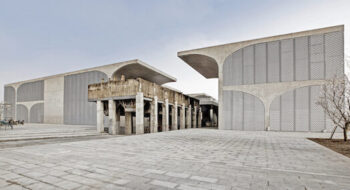
When it opened in 2012, the Long Museum Pudong was the largest private museum in China, founded by billionaire investor Liu Yiqian and his wife Wang Wei. Situated at a former coal-loading wharf by the Yangzi river, this museum of reinforced concrete uses industrial architecture in an impressive, utilitarian avant-garde design. This is one of three museums to feature one of the most important private Chinese art collections in the world. Although it is weighted towards and more celebrated for its contemporary works, the couple have also invested heavily at auction in pieces from Imperial and Republican eras, for example paying nearly $40 million for a tiny Ming dynasty “chicken cup” and controversially immediately celebrating the purchase by drinking tea from it! This building is comprised of several exhibition spaces. Although the previously excellent “permanent exhibition” (moved during Covid) is currently absent, the quality of art shown in this museum is always worthy of attention.
Address: 3398 Longteng Avenue, Xuhui District, Shanghai, Long Museum (West Bund)
Chinese Address: 上海市徐汇区龙腾大道 3398 号龙美术馆(西岸馆)
Web URL: http://www.thelongmuseum.org/en/
Adult ticket price: 320RMB
Closed Monday
2) Power Station of Art
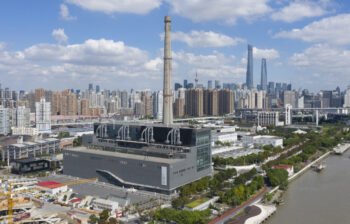
This is the most politically influential contemporary art museum in the city and possibly the country. Owned by the municipality of Shanghai, the state-run Shanghai Contemporary Art Museum, as it is known in Chinese, is the official host of the prestigious Shanghai Biennale. Housed in what was formerly the coal-fired Nansha electricity generation plant, the massive 41,000 m2 (410,000 square feet) space was converted into the Pavilion of the Future for the 2010 Shanghai Expo and two years after was re-purposed to house China’s first public contemporary art museum. There is no permanent exhibition – at any time you will find a number of high-quality temporary exhibitions of notable variety.
This museum is right beside the Team Labs exhibition space and so it would make sense to combine the two in a visit to this area.
Address: 678 Miaojiang Road, Huangpu District, Shanghai, 200011, Power Station of Art
Chinese Address: 海市黄浦区苗江路号上海当代艺术博物馆
Web URL: https://www.powerstationofart.com/whats-on
Adult ticket price: Exhibitions priced variously from 0 – ~100RMB
Closed Monday
3) China Art Museum
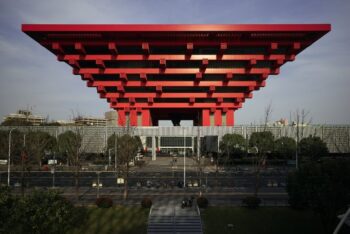
One of the most famous paintings in Chinese art history is the twelfth century “Along the River during Qing Ming festival” (清明上河圖), painted by Zhang Zeduan. This has been called China’s “Mona Lisa” to give you an idea of its importance. 25 cm (10 inches) high and 5.25m (17’) long, it features scenes by the Bian River in the then capital of China, Kaifeng. In scroll format, it reveals life in both rural and urban China at all levels of society. You can see it online here.
Whilst the original is in the Palace Museum in Beijing, the authorities were inspired by the towering historical grandeur of this piece when they sought to anchor The China Art Museum with a suitably impressive work of contemporary art. That is because this architecturally stunning museum, which you can view here, was launched as the iconic monument of the 2010 Shanghai Expo, which following on from the 2008 Beijing Olympics, became Shanghai’s calling card to global relevance in the new millennium.
What you can see here today is a 3D animated version of the classic scroll painting. Called “River of Wisdom”, 128 m long (420’) and 6.5 m (21’) high, this amazing computer graphic with moving figures brings to life the entire scene in 4-minute day and night cycles. If you have even the most fragmentary art history bone in your body, you will be fascinated by it, but please note that other than this exhibit, there’s little reason to inspect the contents of this museum.
Address:205 Shanghai Road, Pudong Xin Qu, Shanghai. China Art Museum
Chinese Address: 上海市浦东新区上南路205号中华艺术宫
Web URL: https://www.artmuseumonline.org/art/art/index.html#page1/1
Adult ticket price: Free admission to permanent exhibition, 20RMB for special exhibition
Closed Monday
4) Museum of Art Pudong
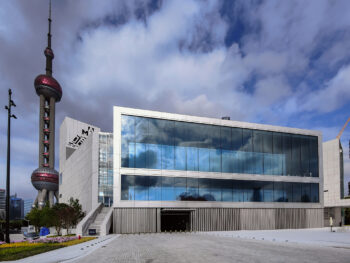
Owned by Lujiazui Group, a state-funded real estate company, primarily tasked with developing key aspects of the Pudong waterfront, the Pudong Art Museum is a 40,000 square meter space devoted to prominent temporary exhibitions in the heart of the city. Located beside the Oriental Pearl Television tower at the tip of the bend in the Yangzi river opposite the British-developed Bund embankment, this museum provides a cultural anchor for what is now probably the world’s most desirable real estate. The 13 galleries, designed by Pritzker winning French architect, Jean Nouvel, are so designed to accommodate both massive installations and the typical maze of whitewashed walls you’d typically expect to find. Also significant are the two glass fronted walkways looking onto the Bund as well as the magnificent views from the roof restaurant and terrace beside it. You should expect to find high quality exhibitions here whenever you visit – for example at the time of writing, the photographic works of Lin Heung Shing, spanning half a century of Chinese history, were featured beside a retrospective of Zeng Fanzhi, one of China’s best known contemporary artists, as well as a fabulous installation by Xu Bing.
Address: The Museum of Art Pudong , No.2777 Binjiang Avenue, Pudong New Area, Shanghai
Chinese Address: 上海市浦东新区滨江大道2777号浦东美术馆
Web URL: https://www.museumofartpd.org.cn/en/index
Adult ticket price: 200 RMB (weekend ticket)
Closed Tuesday
5) Yuz Museum
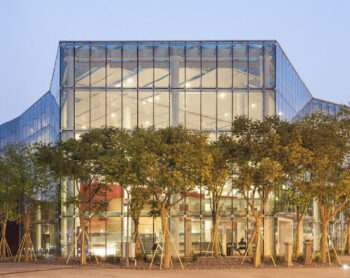
Mr Budi Tek, who passed away in 2022, was one of several successful Indonesian-Chinese entrepreneurs to invest in contemporary Chinese art during its recent rise to prominence. His particular penchant was for installation art, especially very large pieces. His beautiful museum, built on the site of a former hangar of Longhua airport, now houses a portion of his impressive collection as well as offering temporary exhibitions to established artists. It is well worth a visit as part of your investigation of the West Bund area.
Address: No.8, Lane 123, Panding Road, Qingpu District, Shanghai, Yuz Museum
Chinese Address: 上海市青浦区蟠鼎路123弄8号余德耀美术馆
Web URL: http://www.yuzmshanghai.org/?lang=en
Adult ticket price: 140RMB
Closed Monday
6) Team Labs
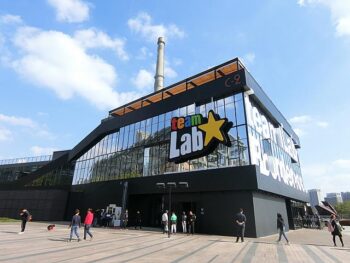
The absolutely spectacular international digital art collective, founded in Japan in 2001, offers a wonderfully immersive 3D digital display at the Epsom Team labs venue close to the Powerstation of Art in the West Bund area in Shanghai. If you have seen one of these before, then this won’t be quite so fabulous, but if you’re a first-timer, this is a must-see.
Address: Unit C-2 No 100, Huayuangang Lu, Huangpu, Shanghai , Team Labs
Chinese Address: 上海市黄浦区花园港路100号C-2馆无界美术馆
Web URL: https://www.teamlab.art/e/borderless-shanghai/
Adult ticket price: 249RMB (for weekend or weekday entry)
7) Fosun Foundation
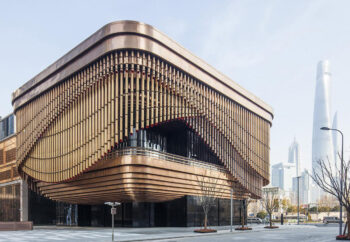
This exhibition space is prominent thanks to the kinetic installation around the museum building. Designed by Brit, Thomas Heatherwick, who created a sensation with the UK Pavilion at the Shanghai Expo and more recently with the 1000 Trees development near the M50 galleries, the perimeter of the museum roof is circled by three layers of bronze tubes of varying lengths hanging down from rails. At regular times of the day, the tubes that resemble waves of bamboo trunks or inverted organ pipes move around the building, revealing a terrace or stage within. Located within the Bund Financial Centre, a smart (in both senses) real estate development, the Fosun Foundation becomes a destination in its own right even without the benefit of the temporary exhibitions it regularly features. The quality of the exhibitions (and the ticket prices) vary from good to excellent, but really both the exterior of the Foundation and the development it introduces are worth a trip in themselves.
Guo Guangchang and his Fosun Group are worthy of a short word. In brief, five young graduates from Fudan University, one of China’s finest, clubbed together in 1992 to start an investment company. Here we are thirty-five years later and it’s one of the largest conglomerates in the world, owning amongst other assets Wolverhampton Wanderers FC, a Premier League football club (soccer), Thomas Cook, the venerable travel firm and Club Med. Congrats to them!
Address: Fosun Foundation, Bund Finance Centre, 600, Zhongshan East 2nd Road Shanghai 200010
Chinese Address: 上海市黄浦区中山东二路600 号200010复星艺术中心
Web URL: https://www.fosunfoundation.com/en/
Adult ticket price: 40 – 300RMB according to exhibition
Closed Monday except public holidays
8) West Bund Project (Pompidou)
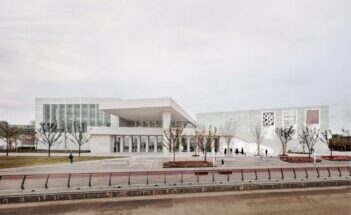
Whilst the David Chipperfield-designed West Bund Museum is one of the city’s most prominent new museums, its politically-inspired ten-year relationship with the Georges Pompidou Centre means that it more naturally commands the attention of local Chinese interested in traveling exhibitions of French art than visiting foreigners investigating local Chinese talent.
“Mirrors of the Portrait. Highlights of the Centre Pompidou collection” is the third and current semi-permanent exhibition from the famed Parisian collection. This will run from July 2023 to November 2024, to be replaced by other differently-themed collections from the same European museum. Reflecting the museum’s dual role also reflecting Chinese art’s role on the global stage, a secondary concurrent exhibition typically extols the merits of a local artist. In addition, the museum features other temporary exhibitions, details of which can be accessed on its website.
Address: No.2600 Longteng Avenue, Xuihui District, Shanghai, West Bund Museum
Chinese Address: 上海市徐汇区龙腾大道2600号西岸美术馆
Web URL: https://www.wbmshanghai.com/en/
Adult ticket price: 100RMB for Pompidou exhibition, 200RMB for all exhibitions
Closed Monday
Mainland China has six main holidays every year in addition to New Years on January 1st which it celebrates in tandem with the rest of the world. The majority of China’s festivals follow the Lunar calendar and are based upon the monthly cycles of the Moon’s phases. Of the six holidays, two are labeled “Golden Week” holidays because they last seven consecutive days. The others comprise of one day holiday.
In practice, a unique feature of mainland Chinese holidays that differs from other countries is that weekends are usually substituted with weekdays next to the actual holiday so as to create a longer 7-day “holiday” period when in actual fact workers only get three days off. It is therefore common for staff working in Chinese companies to work during weekends to make up for this. For example, if the 3 days holiday lands from a Monday to Wednesday, the government will give everyone Thursday and Friday off as well, which added to a weekend equals to seven consecutive days off. However, workers will need to work the weekend prior.
Below is a recap of China’s holidays, as well as advice for what which you’ll want to avoid when planning a private luxury tour with Imperial Tours. Note that Hong Kong and Macau observe slightly different holiday schedules, with some festivals inherited from their respective colonial days.
Also known as Chinese New Year, Spring Festival is one of the most festive holidays in Chinese culture when families gather in the ritual of reunification to send off the old year and greet the new one. Typically an indulgent meal is prepared on New Year’s Eve that includes staples such as dumplings, noodles and fish which are symbolic of longevity. Red clothing is worn, couplets with good wishes adorn doorways, red packets of money are distributed to children, and over the course of the holiday fire crackers are set off to ward off evil spirits (though in recent years the government has limited this due to noise pollution and safety). Spring Festival is one of two ‘Golden Weeks’ where an official “7-day” holiday encourages much of the population to return home, thereby marking the planet’s largest annual human migration with roughly 3 billion passenger journeys taking place, straining transport routes and quite literally reducing the world’s largest economy to a shuddering halt.
Is this a good time to travel? Although temperatures are cold at this time of year, as long as one packs appropriate cold-weather gear and is prepared, it’s a good time to visit China because tourist sites tend to be less crowded.
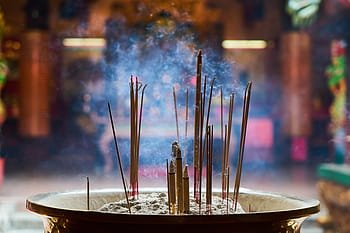
As its name indicates, this holiday commemorates and shows respect to ancestors. Relatives visit graves, offer food, tea or wine to the deceased, burning incense and offering joss paper (representing money … because one still needs cash in the afterlife). Observed by the Han Chinese, families travel to ancestral burial sites to sweep tombs, remove weeds and add fresh soil. Qing Ming Jie was not ‘officially’ celebrated as a day off in the PRC until about a decade ago. When the communist government took power in 1949, they scrapped traditional holidays from their calendar but when China’s May Holiday Golden Week was scaled back in 2007, three traditional holidays were brought back: Qing Ming Festival, Dragon Boat Festival and Mid-Autumn Festival (more on all these holidays as you read on).
Is this a good time to travel? Since this is a short holiday, it’s generally fine to travel during this holiday. We might advise that you avoid certain cities where roadways can become congested and affect touring such as in Hangzhou.
The literal translation for “Wu Yi Jie” is May 1st Holiday. Like many other countries, China celebrates May Day to commemorate its workforce. It was officially established and approved as a holiday by the Chinese government in 1949 following the formation of the Peoples Republic of China. During the Cultural Revolution, this day carried political significance and was considered one of the most important holidays in the country and lasted 7 days. At the time, nationalistic rallies and demonstrations were organized to celebrate its workers, however, today the nature of the holiday has evolved, lending to a more cheerful and casual family holiday with just one day off. As mentioned earlier, in 2007 they reduced this holiday to one day therefore freeing days to dedicate to other holidays.
Is this a good time to travel? Yes, generally a good time with ideal weather in most destinations.
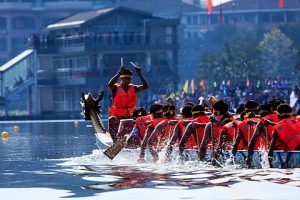
This festivity takes place on the fifth day of the fifth month of the traditional Chinese calendar usually falling in June. Although legendary origins of the Dragon Boat festival vary regionally with an over-arching theme of water-related tragedies, they all carry traditions in Chinese culture such as virtue, spirit, loyalty, honor and love. Dragon Boat Racing is the highlight of this holiday with spectators swarming to watch teams competing in wooden boats shaped and decorated in the form of the dragon and manned by 30 to 60 people paddling harmoniously and swiftly to the sound of beating drums. Hong Kong and Hangzhou are where the most lively dragon boat racing spectacles can be enjoyed.
Is this a good time to travel? Yes, it’s a good time and if you are in the right city, you’ll be able to catch some Dragon Boat races.
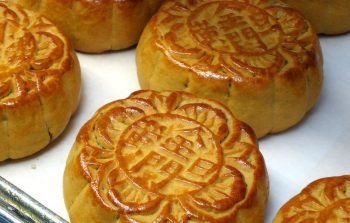
Several varying myths surround the genesis of the Mid Autumn Festival. According to one legend, the moon goddess Chang’e overindulged on an elixir and flew to the moon with her rabbit companion. Another tale says that Chinese emperors in the Zhou dynasty (1045-221 BC) worshipped the moon to bring a bumper harvest the following year. Whatever origin one might believe, this festival is marked by not only distributing moon cakes to family members and colleagues, but also eating them, of course. The densely packed pastries often presented in gorgeous packaging traditionally come with all sorts of fillings such as salty egg yolk (perhaps an acquired taste?), lotus, red been or date paste. Now with a bit of creativity it’s rather common to find moon cakes filled with butterscotch, ice cream or chocolate!
Is this a good time to travel? Yes, very good weather at this time of year.
On October 1st 1949, in front of a crowd of 300,000 people in Tiananmen Square Chairman Mao declared the People Republic of China’s National Day. Called guoqqingjie, the ‘Golden Week’ holiday celebrates the founding of the People’s Republic of China by the Communist Party. Large-scale military displays and parades are held to mark major anniversaries; the last impressive military display took place for the seventieth anniversary of the PRC founding in 2019 resulting in road closures in cities such as Beijing and Shanghai.
Is this a good time to travel? If you can avoid it, it is advisable not to travel domestically during the week around October 1st. Since it is a popular time for domestic tourists to see the country, tourist sites are packed with local travelers.
(These are the official 2020 dates released by the China State Deparment)
– Nadia is one of Imperial Tours’ itinerary designers.
Taijiquan or taichi, a form of Chinese kung fu, is the embodiment of the Chinese philosophical belief that heaven is round. Practitioners of the martial art of taichi use round, circular movements of the arms and body to create the energy that is needed to defeat their opponents. Dr. Hao, a taichi expert with a PhD in Traditional Chinese Sports, guides us through some basic taichi movements in the article ‘Taijiquan Movements and the Thought of Circle in Chinese Culture’. He emphasizes this circular technique is the key to unlocking your power and to understanding the essence of Chinese philosophy. Imperial Tours can arrange private taichi lessons with Dr. Hao in Beijing and with other experts in Hangzhou and Guilin.